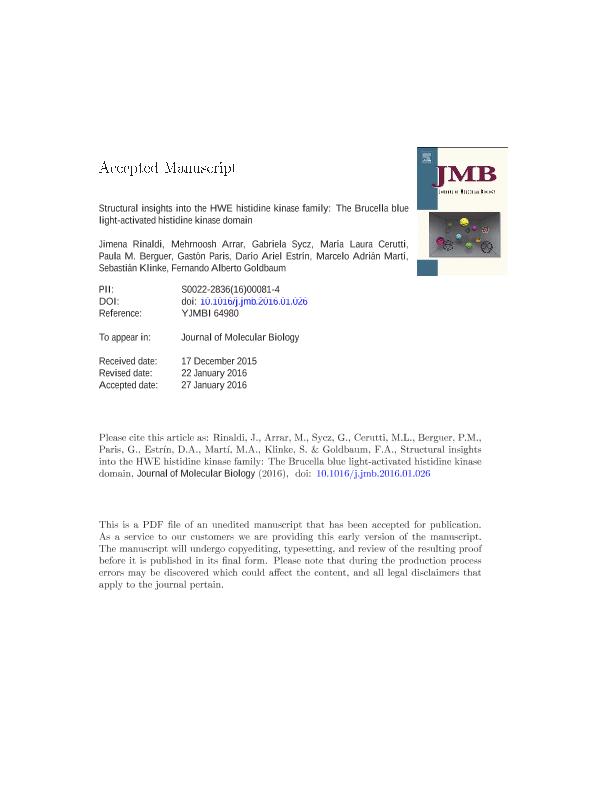Artículo
Structural Insights into the HWE Histidine Kinase Family: The Brucella Blue Light-Activated Histidine Kinase Domain
Rinaldi, Jimena Julieta ; Arrar, Mehrnoosh
; Arrar, Mehrnoosh ; Sycz, Gabriela
; Sycz, Gabriela ; Cerutti, Maria Laura
; Cerutti, Maria Laura ; Berguer, Paula Mercedes
; Berguer, Paula Mercedes ; Paris, Gastón
; Paris, Gastón ; Estrin, Dario Ariel
; Estrin, Dario Ariel ; Marti, Marcelo Adrian
; Marti, Marcelo Adrian ; Klinke, Sebastian
; Klinke, Sebastian ; Goldbaum, Fernando Alberto
; Goldbaum, Fernando Alberto
 ; Arrar, Mehrnoosh
; Arrar, Mehrnoosh ; Sycz, Gabriela
; Sycz, Gabriela ; Cerutti, Maria Laura
; Cerutti, Maria Laura ; Berguer, Paula Mercedes
; Berguer, Paula Mercedes ; Paris, Gastón
; Paris, Gastón ; Estrin, Dario Ariel
; Estrin, Dario Ariel ; Marti, Marcelo Adrian
; Marti, Marcelo Adrian ; Klinke, Sebastian
; Klinke, Sebastian ; Goldbaum, Fernando Alberto
; Goldbaum, Fernando Alberto
Fecha de publicación:
02/02/2016
Editorial:
Elsevier
Revista:
Journal Of Molecular Biology
ISSN:
0022-2836
e-ISSN:
1089-8638
Idioma:
Inglés
Tipo de recurso:
Artículo publicado
Clasificación temática:
Resumen
In response to light, as part of a two-component system, the Brucella blue light-activated histidine kinase (LOV-HK) increases its autophosphorylation, modulating the virulence of this microorganism. The Brucella histidine kinase (HK) domain belongs to the HWE family, for which there is no structural information. The HWE family is exclusively present in proteobacteria and usually coupled to a wide diversity of light sensor domains. This work reports the crystal structure of the Brucella HK domain, which presents two different dimeric assemblies in the asymmetric unit: one similar to the already described canonical parallel homodimers (C) and the other, an antiparallel non-canonical (NC) dimer, each with distinct relative subdomain orientations and dimerization interfaces. Contrary to these crystallographic structures and unlike other HKs, in solution, the Brucella HK domain is monomeric and still active, showing an astonishing instability of the dimeric interface. Despite this instability, using cross-linking experiments, we show that the C dimer is the functionally relevant species. Mutational analysis demonstrates that the autophosphorylation activity occurs in cis. The different relative subdomain orientations observed for the NC and C states highlight the large conformational flexibility of the HK domain. Through the analysis of these alternative conformations by means of molecular dynamics simulations, we also propose a catalytic mechanism for Brucella LOV-HK.
Archivos asociados
Licencia
Identificadores
Colecciones
Articulos(CIBION)
Articulos de CENTRO DE INVESTIGACIONES EN BIONANOCIENCIAS "ELIZABETH JARES ERIJMAN"
Articulos de CENTRO DE INVESTIGACIONES EN BIONANOCIENCIAS "ELIZABETH JARES ERIJMAN"
Articulos(IIBBA)
Articulos de INST.DE INVEST.BIOQUIMICAS DE BS.AS(I)
Articulos de INST.DE INVEST.BIOQUIMICAS DE BS.AS(I)
Articulos(INQUIMAE)
Articulos de INST.D/QUIM FIS D/L MATERIALES MEDIOAMB Y ENERGIA
Articulos de INST.D/QUIM FIS D/L MATERIALES MEDIOAMB Y ENERGIA
Articulos(IQUIBICEN)
Articulos de INSTITUTO DE QUIMICA BIOLOGICA DE LA FACULTAD DE CS. EXACTAS Y NATURALES
Articulos de INSTITUTO DE QUIMICA BIOLOGICA DE LA FACULTAD DE CS. EXACTAS Y NATURALES
Citación
Rinaldi, Jimena Julieta; Arrar, Mehrnoosh; Sycz, Gabriela; Cerutti, Maria Laura; Berguer, Paula Mercedes; et al.; Structural Insights into the HWE Histidine Kinase Family: The Brucella Blue Light-Activated Histidine Kinase Domain; Elsevier; Journal Of Molecular Biology; 428; 6; 02-2-2016; 1165-1179
Compartir
Altmétricas



